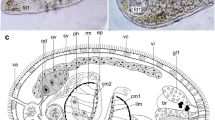Abstract
The sequences of the 18S small subunit ribosomal DNA of five species of cyclophyllidean cestodes from the families Davaineidae, Anoplocephalidae and Dilepididae were determined. A species of tetrabothridid was also sequenced. These 18S sequences were combined with other available eucestode sequences in GenBank. From the 1,838 sites in the alignment, 375 bp (20%) were excluded from the analysis due to alignment issues inferred by manual inspection. Phylogenetic trees were obtained by maximum parsimony, neighbour-joining distance and maximum likelihood methods. Analyses showed that Cyclophyllidea is monophyletic and separate from Tetrabothrius spp. Lyruterina nigropunctata, which is now included in the family Paruterinidae, is more closely related to davaineids of the genus Raillietina than Pseudidiogenes nana (Davaineidae). P. nana and Choanotaenia infundibulum (Dilepididae) derive from the Davaineidae (or Raillietininae). The two species of Taenia (T. parva and T. pisiformis) formed a monophyletic sister group to the Davaineidae and Anoplocephalidae. The systematics of the Paruterinidae have been problematic and our results suggest a review of this family including other species with paruterine organ located in other families. The position of the Idiogeninae as a subfamily in the Davaineidae is also reviewed.

Similar content being viewed by others
References
Bâ CT, Marchand B (1994) Similitude ultrastructurale des spermatozoides de quelques Cyclophyllidea. Parasite 1:51–55
Georgiev BB, Kornyushin VV (1994) Family Paruterinidae Fuhrmann, 1907 (sensu lato). In: Khalil LF, Jones A, Bray RA (eds) Keys to the cestode parasites of vertebrates. CABI, Oxon, pp 559–584
Hasegawa M, Kishino H, Yano TA (1985) Dating of the human ape splitting by a molecular clock of mithocondrial DNA. J Mol Evol 22:160–174
Hoberg E, Jones A, Bray RA (1999) Phylogenetic analysis among the families of the Cyclophyllidea (Eucestoda) based on comparative morphology, with new hypotheses for co-evolution in vertebrates. Syst Parasitol 42:51–73
Jones A, Bray RA (1994) Family Davaineidae Braun, 1900. In: Khalil LF, Jones A, Bray RA (eds) Keys to the cestode parasites of vertebrates. CABI, Oxon, pp 407–441
Khalil LF, Jones A, Bray RA (eds) (1994) Keys to the cestodes parasites of vertebrates. CABI, Oxon
Kimura M (1980) A simple method for estimating evolutionary rates of base substitution through comparative studies of nucleotide sequences. J Mol Evol 16:111–120
Kornyushin VV (1989) Monogenea and Cestoda, vol 3, Davaineoidea, Biuterinoidea, Paruterinoidea. Fauny Ukraini 33
Kumar S, Tamura K, Jakobsen IB, Nei M (2001) MEGA 2: molecular evolutionary genetic analysis software. Bioinformatics 17:1244–1245
Littlewood DTJ, Bray RA (eds) (2001) Interrelationships of Platyhelminthes. Taylor and Francis, London
Mariaux J (1996) Cestode systematics: any progress? Int J Parasitol 26:231–243
Mariaux J (1998) A molecular phylogeny of the Eucestoda. J Parasitol 84:114–124
Strimmer K, Von Haeseler A. (1996) Quartet puzzling: a quartet maximum likelihood method for reconstructing tree topologies. Mol Biol Evol 13:964–969
Strimmer K, Goldman N, Von Haeseler (1997) Bayesian probabilities and quartet puzzling. Mol Biol Evol 14:210–211
Swiderski Z, Tkach V (1997) Differentiation and ultrastructure of the paruterine organs and paruterine capsules in the nematotaeniid cestode Nematotaenia dispar (Goeze, 1782) Lühe, 1910, a parasite of amphibians. Int J Parasitol 27:635–644
Swofford DL (2002) PAUP*. Phylogenetic Analysis Using Parsimony (*and other methods). Version 4. Sinauer, Sunderland, Mass.
Thompson JD, Gibson FP, Jeanmongin F, Higgins DG (1997) The CLUSTAL X windows interfase: flexible strategies for multiple sequence alignment aided by quality analysis tool. Nucleic Acids Res 24:4876–4882
Acknowledgements
We wish to thank Dr. Mariano Hernández Ferrer for helping with this work, as well as the “Excelentísimo Cabildo Insular de Tenerife” and 2001SGR00088 project by the “Comissionat por la Recerca y Universitats de la Generalitat de Catalunya (Catalonia Government)” for their support.
Author information
Authors and Affiliations
Corresponding author
Rights and permissions
About this article
Cite this article
Foronda, P., Casanova, J.C., Valladares, B. et al. Molecular systematics of several cyclophyllid families (Cestoda) based on the analysis of 18S ribosomal DNA gene sequences. Parasitol Res 93, 279–282 (2004). https://doi.org/10.1007/s00436-004-1130-8
Received:
Accepted:
Published:
Issue Date:
DOI: https://doi.org/10.1007/s00436-004-1130-8




